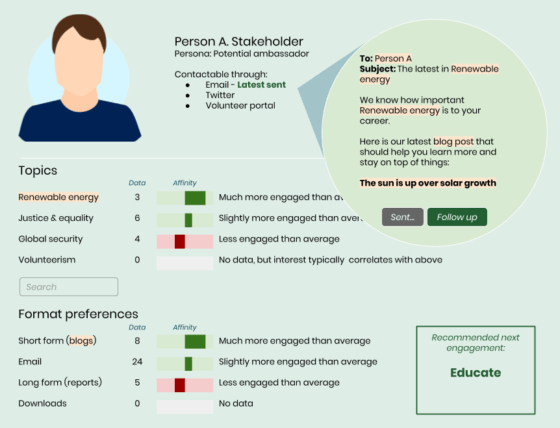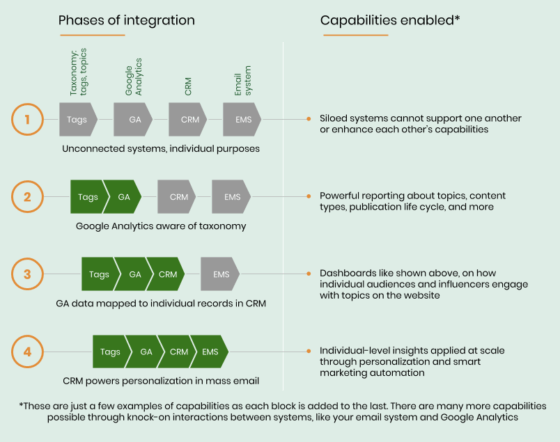When faced with the daily crush of responsibilities and addressing your organization’s most immediate needs, it is easy to lose sight of the potential of your work, and how each piece of your outreach portfolio can support one another. When you rush to get a solution in place, it becomes difficult to recognize the ways in which that same work could be leveraged to enable tremendous new capabilities for your organization.
In analytics in particular, most organizations content themselves with the default metrics of their website, social, and email marketing systems, the so-called “vanity metrics” like pageviews and impressions that offer very little actionable information about how your efforts are leading to audience engagement.
More than just being technically sound, your analytics need to integrate with your digital strategy to be successful.
Every organization, large or small, has the potential to enable powerful reporting that can directly inform detailed content and outreach decisions, and even feed back into marketing platforms like your email marketing system, to unlock incredible new capabilities, like personalization, that you already have access to, but aren’t prepared to use.
For your data to reach its full potential, it must be tightly integrated with your entire organization. More than just being technically sound, your analytics need to integrate with your digital strategy to be successful. This means defining and delivering metrics that are unique to your digital strategy and audiences, and it means establishing publishing and marketing processes that respond to these metrics by changing course appropriately.
An analytics system that is carefully configured, integrated across all communications platforms (e.g. website, email system, donation platform, CRM, etc…), and made aware of your content strategy can yield truly insightful dashboards. At their best these dashboards don’t just inform your staff, but drive your staff directly to take action and keep you apprised of audience engagement that is automatically executed by your data-driven engagement platform.

With a well-developed and integrated content strategy, analytics framework, and engagement platform, you can have a report like the above that lets you inspect an individual audience member, see how their interests and affinity vary across different types and categories of your organization’s content, and use this information to send targeted and personalized outreach that has a higher chance of deepening their engagement and getting them to help deliver on your organization’s mission.
What you need to have in place in order to make this report:
- A clear and meaningful content taxonomy (e.g. topics, tags, types, or other groupings of content) used across your website(s)
- And consistency in the application of that taxonomy (all content is appropriately tagged with most relevant and/or all relevant terms)
- A well-defined audience engagement strategy that focuses on multi-channel interaction
- Taxonomy integrated with Google Analytics as dimension/content grouping
- Or, better yet if it is integrated directly with your CRM, but this is a rare option
- Google Analytics traffic mapped to individuals e.g. Through User ID system in GA, powered by CRM, AND/OR through alternative ID mapping methods in GA, and subsequently pushed to CRM
- CRM configured with custom fields to store things like affinity for interests and content types
- CRM and/or email system set up to sync with Google Analytics to gather, store, and update the latest information on individuals’ affinities
- Email system offers personalization fields to push interests from user fields into messages
- Email system offers modular content to add “latest” copy
- Best scenario, this is linked to CMS to reduce migration/duplication of effort
Unlock levels of value along the way
The above list looks like a lot because it is, and there is a long way to go from having passable versions of each of the above requirements and truly mastering an integrated system that yields self-sustaining growth. That is exactly why succeeding in the above sets an organization apart and offers industry-leading audience engagement. However, planning for a comprehensive engagement architecture does not mean you have to wait until it is completed to take advantage of each improvement you make.
Many monolithic systems that are billed as “all-in-one” solutions can cost hundreds of thousands or even millions of dollars to implement, are unusable until they are launched, and ultimately fall short of their promise. Instead, our preference is to work with the systems you already have in place (that work well to their existing purposes) and iteratively enhance, integrate, or replace each piece to add value. This way, the eventualities of evolving needs, learning as you go, and running into budget constraints can leave you with a familiar and functioning set of systems that work for your organization.

Each step and each integration described above offers its own new capabilities and benefits to content creation and outreach, empowering your team and your tools with better access to better data to guide decision-making.
With this in mind, it becomes clear that there is no need to “wait until you’re ready” for advanced communications and outreach capabilities, because there is always a next step that you can take right away to get you closer to your ideal state. No matter your bandwidth, and no matter your budget, plan to continue integrating your data and your systems piece by piece, and take advantage of the new capabilities you unlock along the way.
So how can ParsonsTKO help ?
The hardest part of taking this journey is knowing the way, which is why we often start working with clients by conducting a roadmapping and planning effort to create the vision of what your organization can accomplish at various stages of future development. These strategies yield a clear set of steps, which can then be implemented piece by piece as their own separate projects designed to solve problems and add new functionality, or can be addressed through one of our subscription services, allowing our team to integrate with yours and continuously grow your capabilities while helping you take advantage of what you have.






